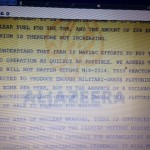CHARLOTTE, N.C. (AP) — She was a Serbian-born model and self-described “wild-child” who said she began walking runways in her new North Carolina hometown at age 12.
But a blossoming career in modeling for Mirjana Puhar, who reached national attention on “America’s Next Top Model,” ended tragically when police found her body and two others in a house in Charlotte this week.
Charlotte-Mecklenburg Police say 19-year-old Emmanuel Jesus Rangel-Hernandez is charged with three counts of first-degree murder in the deaths of the 19-year-old Puhar and two other victims. Authorities have said the killings were drug-related, but have not said how the three were killed.
The Charlotte Observer reported on Puhar’s emerging career in a story published in 2014. She told the newspaper that her family fled Serbia after the Kosovo War and moved to North Carolina a decade later.
*** This led Senator Grassley, Chairman of the Judiciary Committee to ask in written form of Secretary of Department of Homeland Security, Jeh Johnson if Hernandez was in the United States under the White House, Barack Obama DACA program. Several days later, the answer is YES. From Daily Caller: “Mr. Rangel-Hernandez allegedly applied for and received deferred action under the President’s Deferred Action for Childhood Arrivals (DACA) program,” Grassley, a Republican from Iowa, wrote to Johnson.
There are more chilling facts in this case. He’s also being charged with a murder in Matthews, North Carolina, that occurred on February 22 at a hotel. WCNC reports that the victim in that shooting is named Rosool Jaleel Harrell. Cops in Matthews say that Rangel has been charged along with a man named Edward Sanchez, who is also charged with murder and Emily Isaacs, who is charged with accessory after the fact. Both of those suspects were arrested in Harris County, Texas.
Until just a week ago when a Federal judge ordered a suspension of DAPA, DACA continues and is the program is defined below:
What Is DACA
On June 15, 2012, the Secretary of Homeland Security announced that certain people who came to the United States as children and meet several guidelines may request consideration of deferred action for a period of two years, subject to renewal. They are also eligible for work authorization. Deferred action is a use of prosecutorial discretion to defer removal action against an individual for a certain period of time. Deferred action does not provide lawful status. NOTE: On November 20, 2014, the President made an announcement extending the period of DACA and work authorization from two years to three years.

